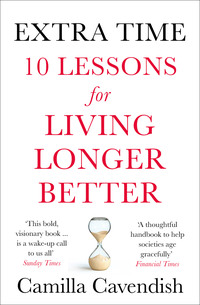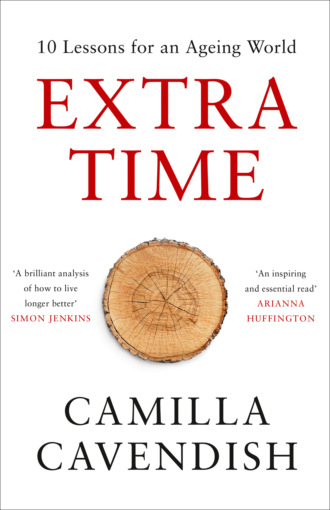
Полная версия
Extra Time: 10 Lessons for an Ageing Society - How to Live Longer and Live Better

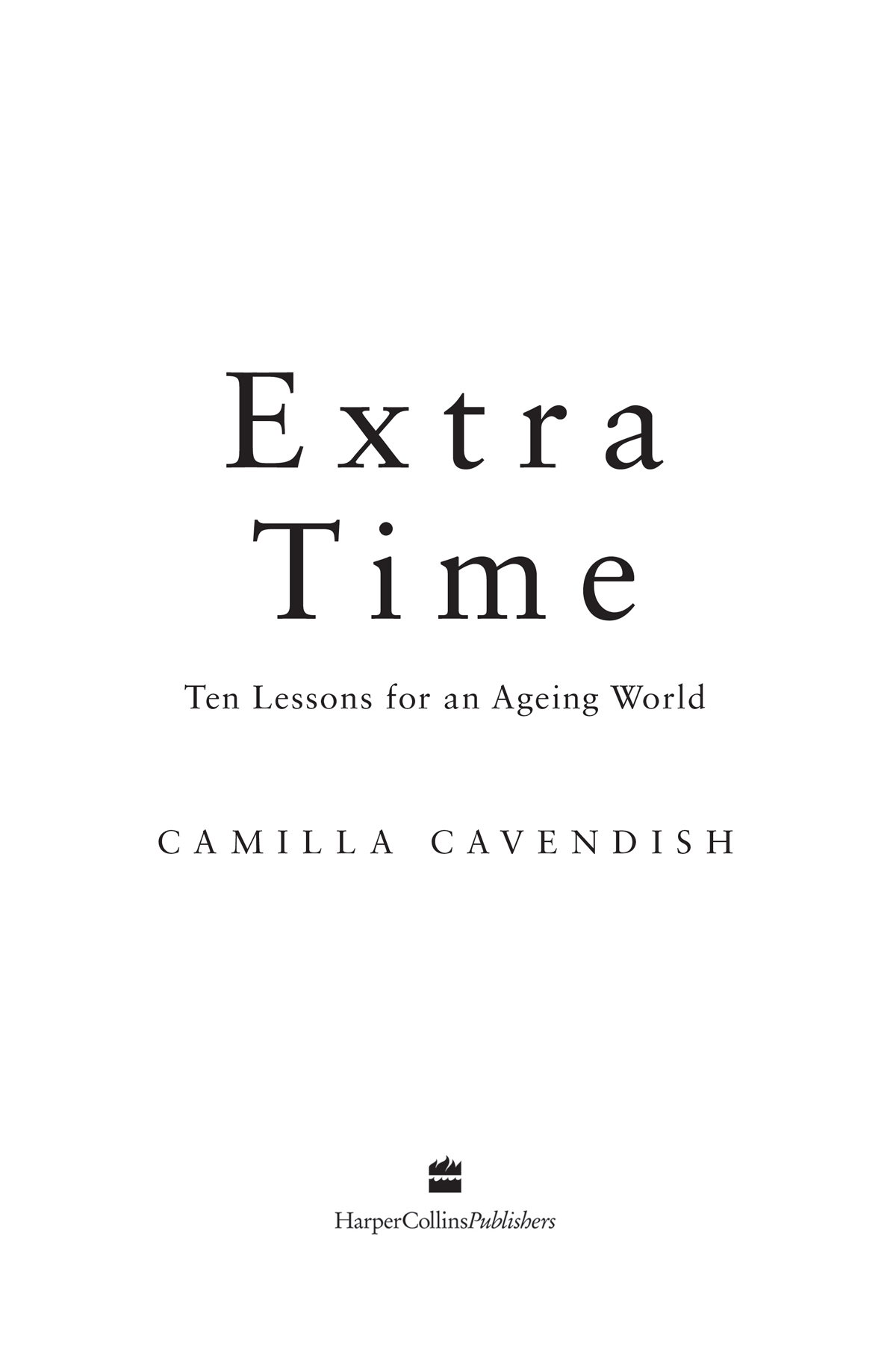
Copyright
HarperCollinsPublishers
1 London Bridge Street
London SE1 9GF
www.harpercollins.co.uk
First published by HarperCollinsPublishers 2019
FIRST EDITION
Text © Camilla Cavendish 2019
Illustrations © HarperCollinsPublishers 2019
Cover design by Steve Leard © HarperCollinsPublishers 2019
Cover photograph © Shutterstock.com
A catalogue record of this book is available from the British Library
Camilla Cavendish asserts the moral right to be identified as the author of this work
All rights reserved under International and Pan-American Copyright Conventions. By payment of the required fees, you have been granted the nonexclusive, non-transferable right to access and read the text of this e-book on screen. No part of this text may be reproduced, transmitted, downloaded, decompiled, reverse engineered, or stored in or introduced into any information storage retrieval system, in any form or by any means, whether electronic or mechanical, now known or hereinafter invented, without the express written permission of HarperCollins e-books.
Find out about HarperCollins and the environment at www.harpercollins.co.uk/green
Source ISBN: 9780008295158
Ebook Edition © May 2019 ISBN: 9780008295189
Version 2019-04-25
Contents
Cover
Title Page
Copyright
Dedication
Introduction
The New World of Extra Time
1 The Death of Birth
Demography tips the balance of power
2 Younger Than You Thought
The stages of life are changing
3 Just Do It
If exercise and diet was a pill, we’d all be taking it
4 No Desire to Retire
Don’t give up the day job
5 New Neurons
Old brains can learn new tricks – and they must, to keep in shape
6 In the Genes
Immortality isn’t here yet, but anti-ageing drugs are on the way
7 Out of the Ghetto
Everyone needs a neighbourhood
8 Health Revolution
Robots care for you, humans care about you
9 Finding Ikigai
Purpose Is Vital
10 Generation Hexed
We need a new social contract
Epilogue
A Different, Better World
Endnotes
Further Reading
Acknowledgements
List of Searchable Terms
About the Publisher
Dedication
In memory of Richard Cavendish,
1930–2016
Introduction
The New World of Extra Time
IN 2018, A DUTCHMAN began a court battle to make himself legally 20 years younger. Emile Ratelband, 69, told a court in Arnhem in the Netherlands that he did not feel ‘comfortable’ with his official chronological age, which did not reflect his emotional state – and was preventing him from finding work, or love online. He wanted to change his date of birth from 11 March 1949 to 11 March 1969.
Doctors had told him that his body was that of a 45-year-old, Ratelband argued. ‘When I’m 69,’ he said, ‘I am limited. If I’m 49, I can take up more work. When I’m on Tinder and it says I’m 69, I’m outdated.’ His friends had urged him to lie, he claimed, but ‘if you lie, you have to remember everything you say’.
Ratelband compared his quest to be identified as younger with that of people who wish to be identified as transgender – implying that age should be fluid. He said his parents were dead, so could not be upset by his desire to turn back the clock. He even offered to waive his right to a pension.
Ratelband, a ‘positivity coach’, is a provocateur who enjoys attention. The court turned him down, ruling that an age change would have ‘undesirable implications’ for legal rights, such as the right to vote. But this seemingly frivolous case actually illustrates something profound: we are on the cusp of an entirely new period in our history, which is coming at us fast.
This is the advent of Extra Time.
If you are in your fifties or sixties today, you have a very good chance of living into your nineties. If you play your cards right and have luck on your side, many of those years could be healthy and productive. Our chronological age is becoming decoupled from our biological capabilities.
In football, ‘extra time’ is the period when there’s everything still to play for. That will be true for many of us. Droves of people are ‘unretiring’ and going back to work. Advances in biology and neuroscience will help us stay younger longer. But our institutions, and our societies, have not caught up. Ratelband’s looks, his physical strength, his ambitions are out of kilter with what we traditionally associate with being 69. He feels compelled to go to the extreme lengths of changing his birth date. Why can’t we, instead, just change our view of what it means to be 69?
The Fierce Urgency of 100
In 1917, King George V of England sent the first ever telegram to a centenarian. It was handwritten, and delivered by bicycle. In 2017, Queen Elizabeth II sent out thousands of 100th birthday cards, with a team of seven employed to administer them all.1
The era of Extra Time will see a growing number of centenarians. The Office for National Statistics estimates that one in three babies born in Britain today will live to 100. Some scientists even think we could live to 150 (as we will see in Chapter 6).
This should be a fairy tale. Instead, there are widespread fears that we are sitting on a ‘demographic time bomb’, with droves of elderly people about to bankrupt governments and hurt GDP. If people get less creative as they age, and stop work around 60, economies could slump and younger generations could face crippling taxes.
But it doesn’t have to be that way. More and more people, like Emile Ratelband, have no desire to retire. Fears about the declining ratio of workers to pensioners rest on the official definition of ‘working age’, as 15–64. But David Hockney became the world’s foremost iPad painter at 76; Tina Turner made the cover of Vogue at 73; Yuichiro Miura climbed Everest aged 80. Warren Buffett is still investing in his eighties and David Attenborough is making hit TV series in his nineties. Behind them stride loads of ordinary people who see Extra Time as an opportunity, who are starting businesses and are highly productive. They can defuse the time bomb.
Will they be fit enough? When a football match goes into Extra Time, there’s a premium on fitness. Here, the omens are pretty good. Today’s seventy-somethings are sprightlier than ever before, and the incidence of dementia is falling. There is work to do, though, on health inequalities. Increases in life expectancy have slowed in the UK,2 where the average life expectancy at birth is now 82 for women and nudging 80 for men. In America, life expectancy at birth has dropped for three years in a row,3 partly because of the opioid epidemic. Both countries face a battle against obesity – and poverty (see here and here).4
Globally, demographers think these dips in life expectancy are probably blips. The twenty-first century will be defined by people living longer, in societies which are growing older much faster than we have fully realised. But are they ageing faster? Only if you cling to out-of-date notions of what it means to be 50, 65 or 80.
Islands of Extra Time
On the Pacific island of Okinawa, there is no word for retirement. The longest-living women in the world are still caring for great-grandchildren when they hit their 100s. Okinawans are rarely lonely, because they are supported by a network of friends, the ‘moai’, who are committed to share both good times and bad. The typical Okinawan house doesn’t have much furniture: people tend to eat sitting on the floor, so they are getting up and down many times a day. They also have a strong sense of ‘ikigai’, roughly translated as ‘reason for being’. My Japanese friends tell me that you find your ikigai at the place where your values intersect with what you enjoy doing, and what you are good at.
Okinawa is one of the Blue Zones, the parts of the world identified by researcher Dan Buettner, where people have low rates of chronic disease and live exceptionally long lives. While it’s not possible to distil a single magic ingredient, common to all Blue Zones are plant-based diets with very little processed food, strong friendships and a sense of purpose, lots of sleep and strenuous physical activity.
We can’t all live on islands, getting up with the sun and tilling the soil. But the Blue Zones do suggest that what we think of as ‘normal’ may be a very poor version of what our natural selves could be. And that is incredibly positive.
Why I Wrote This Book
I started writing this book in 2016, after my beloved father died. He had dreaded getting ‘old’, so much so that it whittled down his life much too early. I remember his gloom on his fiftieth birthday. As we sat together on his favourite cliff in Cornwall, watching the waves break below, he said he felt that everything was ‘over’. I was a child, and 50 was older than I could imagine. But I did notice, from that point on, that my father started to think of himself in a different way. He would say ‘Oh, I’m too old for that’ with a sigh. After my mother left him, he refused to get a cat, although he adored them, on the basis that it might outlive him and be left homeless. He was 58 when he got divorced, and missed our two cats, Arthur and Merlin, most terribly (they went with my mother in the divorce, along with a hotly contested dining table). He ended up living, in largely excellent health, to 86. And he lived all that time without cats, who could have kept him company.
After he died, I couldn’t stop thinking about the way age can become a barrier.
My mother lied about her age until she was 72, because she was terrified she would lose her job as a secretary, and default on the mortgage she took out after the divorce. This created a huge burden of deception. She never dared join the company pension scheme for fear of being found out. She also hated the feeling that, as her looks dwindled, she was becoming invisible. She refused to let my children call her ‘Granny’, or refer to her in any way as a grandmother, which made things awkward between them.
In conventional terms, my parents were ‘old’ – almost 40 – by the time they conceived me. They’d met at Oxford University in the 1950s, she a glamorous American who’d grown up in Greenwich, Connecticut, he the bookish son of an English vicar. Their world was an intellectual, bohemian one of artists and academics for whom work was passion, savings in the bank negligible and ‘retirement’ anathema. My father dictated his final article for History Today magazine from a bed in Charing Cross Hospital. My mother was campaigning to help a friend get his job back when she had her final heart attack.
My thoughts about my parents chimed with my growing professional awareness of our fatalism about older people. As a journalist, and through my work for the Department of Health, I have met many compassionate nursing and care staff struggling against tick-box cultures and low pay.5 When I sat on the board of our national hospital and care-home regulator,6 it was clear that patients were being warehoused in post-war silos. As head of the Number 10 Policy Unit, I worked to introduce the sugar tax and other measures to combat obesity, a condition which is making people old before their time, but is portrayed as a ‘choice’. And I felt that media excitement about living to 100 jarred with a lack of ambition about what that should mean.
I have written this book to challenge our notions of ageing, and find out what different countries are doing to build a new world for Extra Time. I have been privileged to meet many wonderful pioneers, who I think of as ‘rebels against fate’, who are refusing to dress demurely, stop work or be carted off to care homes.
The rebels against fate intuitively understand that something fundamental has changed. They are all saying, in different ways, that age should not define us. My goal in this book is to spread their message, to persuade you to contemplate your own future before it’s too late, and to try to change the pattern of thinking in our societies about what we mean by ‘old’. Because it sure as hell isn’t 50, whatever my father thought. Yet much of the data about the ‘old’ still starts at 50 – when some of us will be only halfway through our lives.
This book is not a rose-tinted rhapsody. I don’t predict that we will all be skipping our way cheerfully to 120. In fact, I’ve written it partly as a warning.
Living longer is not a blessing, in my view, unless it is living better for longer. Neither of my parents had any desire to live to 100. What they cared about was living as full a life as possible, and then hopefully checking out as fast as possible.
One of the most shocking things I have confirmed, in researching this book, is just how drastically the futures of the rich and poor, the highly educated and the less educated are diverging. Only Japan has begun to effectively address the health problems which mean that some people are what the Japanese call ‘Young-Old’ at 80, while others are ‘Old-Old’ at 65. For me, this is one of the biggest ethical challenges of our time. If we don’t fix it, the rich, the educated and the lucky may still be thriving at 90 – but they will be living in societies which cannot afford to look after those who are less fortunate. We must prevent that from happening: since one measure of a civilised society is how it treats its elderly.
A Different, Better World
This book spans many aspects of a huge topic. I have tried to break it down into ten lessons, each of which reflects what I have learned from experts, academics and policymakers, but also from those on the frontline. I’ve interviewed biologists who are challenging the very notion that ageing is inevitable; neuroscientists who are finding ways to stave off brain decline; and social entrepreneurs who are working to bring the generations together, rather than letting them drift apart.
I begin by surveying the demographic trends, longer lives and plummeting birth rates, which pose a profound and unexpected challenge to our species. Voluntary childlessness was always presumed to be evolutionarily impossible. But birth rates are falling so fast that some countries will soon shrink. China is growing old before it gets rich. If America stays vibrant, this could alter the geopolitical balance of power.
Almost without noticing, we have created an entirely new stage of life – an extended middle age. I look at this new stage in Chapter 2, and at how the media, and governments, send the wrong signals. I look at alternative ways to compute healthy lifespan, and at the widening gap between the rich and educated, and the less fortunate. In Chapter 3 I explore what true biological ageing might look like, without junk food and sedentary lifestyles, and argue that obesity is making some people old before their time. I am not advocating any particular product or medicine in this book, but I do suggest that the evidence for aerobic exercise, and against sugar, is compelling.
Some Silicon Valley billionaires are on a quest to find immortality. Their research is fascinating. Especially intriguing are the ‘super-centenarians’, whose risk of dying levels off after the age of 105. But my chief interest is in improving life, not prolonging it. In Chapter 5 I describe developments in neuroscience which show that we are never too old to learn. I look at what kinds of brain training might help keep us sharp, and at the ‘cognitive reserve’ which may be protective against Alzheimer’s. In Chapter 6 I hunt down pills which claim to have anti-ageing properties, harnessing genes and proteins in our bodies. These discoveries raise what may sound like an odd question: should we treat ageing as a disease? But in another decade it may seem eccentric to treat one illness at a time, rather than to use the underlying circuits in our bodies to ward off many different conditions.
That doesn’t mean we won’t get ill. In Chapter 8 I meet cold but useful robots in Japan, and warm inspiring nurses in Holland, and I argue for more compassionate health and care systems based on a blend of technology and humanity.
The challenge for CEOs is considerable. The multi-generational workforce is on the way, but it will not be straightforward to manage. Even though jobs are being automated, retiring babyboomers are creating skill shortages. We need a fourth stage of education, to match the fourth industrial revolution. Luckily, pioneers are shrugging off the notion that retirement is good for you, and are starting successful businesses (Chapter 4). Others are creating the kinds of neighbourhoods we will all need, to look after each other (Chapter 7). Still others are harnessing the energy and altruism of older people to do good, whether that is grandmothers in Zimbabwe or hospital volunteers in England (Chapter 9).
Longer lives, and shrinking numbers of young people, are putting pressure on the social contract. How will our societies look after the old, without bankrupting the young? In Chapter 8 I propose a new settlement for funding social care, drawing on the examples of Germany and Japan. In Chapter 10 I argue that the new divide is not simply between young and old, but between the skilled and the less skilled, at all ages.
One of the greatest blocks to progress is our own prejudice. We need to transform our attitudes, and realise it’s not old age that’s getting longer, it’s middle age. The challenge is urgent. The world is becoming an older one, faster than anyone anticipated. That’s not only because we are living longer, it’s also because of what I call the ‘Death of Birth’, as described in the next chapter.
1
The Death of Birth
Demography tips the balance of power
BY 2020, FOR THE first time in history, there will be more people on the planet over 65 than under 5.1 More grandparents than grandchildren.
Two trends are driving this ageing of the world. First, we are living longer. In the twentieth century, average life expectancy increased by 30 years in most developed countries, because of better nutrition and sanitation, and medical advances. Men currently live longest in Switzerland, with an average life expectancy at birth of 82; women live longest in Japan, to about 87. Australia, Israel, Canada, South Korea and most Western European countries are close behind. The gap between men and women is narrowing, because men who once led rackety lives (drinking and smoking) are cleaning up their act.
The second reason is that the world’s women are turning away from motherhood. In 1964 the average woman had just over 5 children; in 2015 she had only 2.5.2
There are now 83 countries, home to nearly half the world’s population, with fertility rates below the ‘replacement rate’ – roughly 2.1 births per woman – needed to maintain the population. Australia, New Zealand, Brazil, Chile and almost every country in Europe now has fertility below that level. South Africa and India are moving rapidly towards replacement rate, with birth rates of 2.5 and 2.3 respectively.3
The changes will alter the shape of countries. Japan’s population is already shrinking. By the middle of this century Italy, Poland, South Korea and Russia will be dwindling too.4 And these shifts could redraw the geopolitical balance of power: between countries on an ageing, shrinking trajectory – notably China – and countries which are sustained by younger, immigrant populations – currently the US.
Africa will provide the young of the future. The populations of 26 African countries are expected to double between 2017 and 2050, adding another 1.3 billion people to that continent.5
Fewer humans should be good news for the environment, once global population peaks (some time after 2070, though estimates range from 9 to 11 billion).6 But the impact on humans can already be glimpsed. Visit Japan’s Akita Prefecture, where over a third of residents are over 65 and the main growth industry is funeral parlours.7 Or go to Rudong in eastern China, where half the schools have closed in the past 15 years as the younger generation moves away.
Demography is changing not only the landscape, but the very meaning of family. What networks will we rely on, as children become scarce?
The Chinese government has passed an ‘Elderly Rights Law’, threatening to fine children who don’t visit parents often enough.8 But the children are fighting back. ‘What is considered “often”?’ complained one poster on Weibo, the Chinese Twitter.9 ‘It’s fine that no one is paying for us to visit our parents, but is there someone who can give us time off to do it?’ asked another, refusing to buy into traditional notions of family.
The best way to visualise what is happening is through the population pyramids used by demographers. In 1950, if you laid out the population of any nation with each age group represented by a bar, the youngest at the bottom and the oldest at the top, it looked like a pyramid, with the young outnumbering the old. That has been the shape throughout recorded history, as this chart for Japan shows:
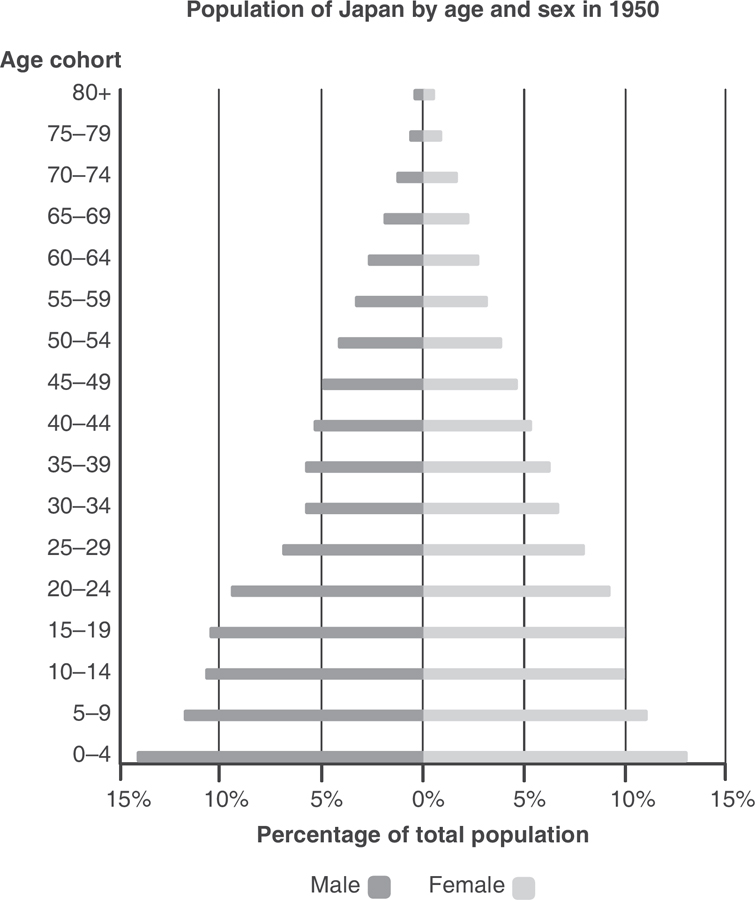
Since then, falling birth rates and longer lifespans have changed the picture dramatically. Japan, the world’s oldest society, has one of the lowest birth rates in the world: 1.4 births per woman. Fifty years ago, life expectancy in Japan was about 72 years. Now it is 84. In 2015, over a quarter of the population was over 65, turning the pyramid into a barrel:
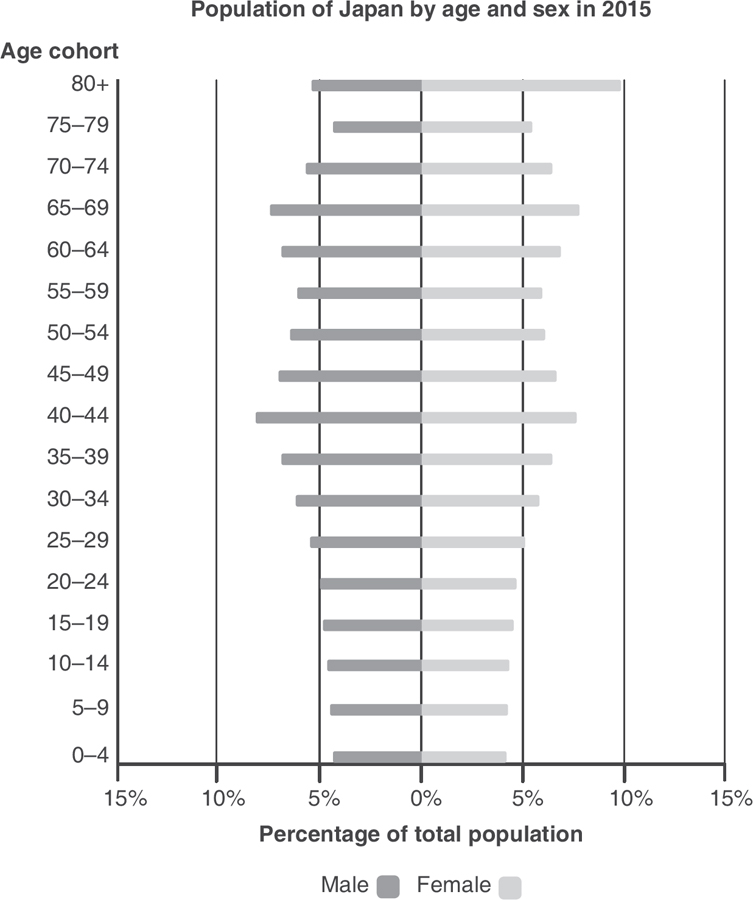
Between now and 2050, longer lifespans will continue to alter the pyramids’ shape. The fastest growing group in the world population will be those aged over 80. In Japan, the pyramid will stretch up and outwards, to look more like a flowerpot:
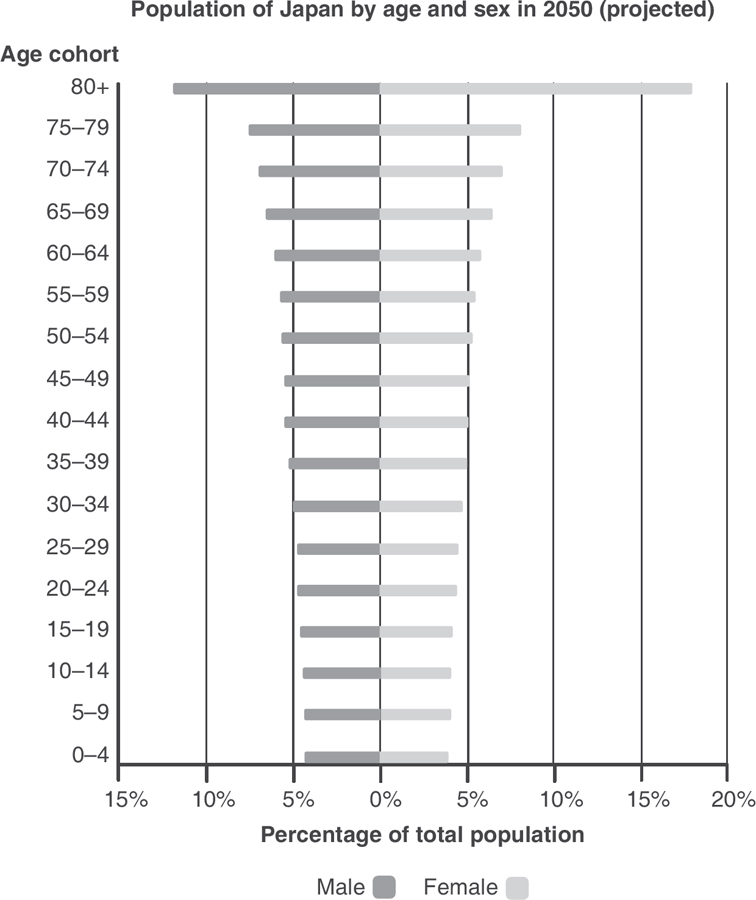
One former health minister has predicted that ‘the Japanese race will become extinct’. The first question is why? Why have millions of individuals simultaneously changed their minds about having children?
Japan: ‘Herbivore Men’ and Career Women
‘Men here don’t want a woman who’s cleverer than them,’ says Keiko, a Japanese executive in her early forties, who is wearing a smart suit and demure heels when we meet in the lobby of the Tokyo Hilton. ‘They worry you might be demanding, that you might be demanding in bed too. And I just think, why bother? Why bother with a guy who’s more interested in his Xbox?’
Something strange is going on in Japan, which now has the world’s highest proportion of old people. In 2013, it was claimed, more nappies were sold for elderly, incontinent people than for babies.10 That ugly benchmark proclaims the raw truth: babies have gone out of fashion.


